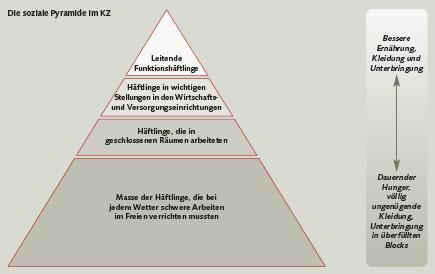Hierarchy and functionary prisoners
The Camp’s Hierarchy
The SS classified prisoners according to its ideological scale of “racial value”. Prisoners from groups classified as “racially inferior” were at the bottom of the camp’s hierarchy and therefore had to endure even more deprivation than their fellow prisoners. Knowledge of a foreign language could help prisoners climb the rungs of the pecking order. Administrative and labor organisation positions were given almost exclusively to prisoners who spoke German. Prisoners who worked in positions that were important to the SS were generally subjected to less brutal treatment. Prisoner functionaries received more food, better clothes and were often housed separately. Sometimes, a prisoner’s number also affected his position in the camp’s hierarchy. Because of the long time they had spent in the camp, prisoners with low numbers were regarded as experienced concentration camp inmates, to whom other prisoners had to defer.
Prisoner Functionaries
Also, any member of the SS guards had the power to mete outpunishments at his own discretion. Many prisoner functionaries also enforced their orders by beating prisoners in order to maintain their own authority in relation to that of the SS. While ordinary prisoners had to fight for survival every day, important prisoner functionaries were able to afford good food, clean uniforms, and sometimes even personal servants. Some used their position of power to obtain food from parcels their fellow prisoners had received or to force other prisoners to have sex with them.
